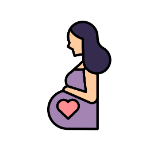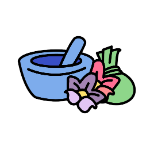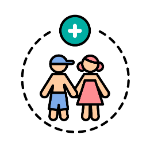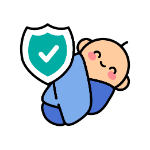
Q&A With Expert Series: Answers For Your Postpartum Jitters
Are you a new mom or an existing mom but still haunted by postpartum traumas? We understand your after-birthing jitters! It’s perfectly normal and usual for moms to go through certain emotions and traumas after their birthing. Questions ranging from your health to questions regarding the well-being of your little one will always occupy your thoughts.
(Q&A Expert Series with Dr. Haslinda)
Hence why we have reached out to an expert who can help you to calm down. Mommies, we are pleased to introduce Dr. Haslinda Binti Mohd Daud, an obstetric and gynecologist from Pantai Hospital Ampang. This week, you get to lower your postpartum anxieties from answers by our expert for your most common questions. Come, let’s keep going!
Q1. What are the key tips in managing pregnancy hormones, diets, and lifestyle changes during postpartum?
Key tips: Relax, distract, express yourself, and have good self-care.
Many mothers experience postpartum blues 2-3 days after giving birth and it can continue for a few weeks. It is normal to feel these labile moods, sadness, exhaustion, irritability, and spontaneous crying because of a drop in pregnancy hormonal level after birth. When things feel emotionally very difficult, just lay back and relax. Do a breathing exercise (Close your eyes, inhale deeply for 3-5 seconds and give a long exhalation; breathe out your difficulty) a few times till you feel calm. Distract yourself with other things, for example, reading, watching tv, listening to your favorite music or song, going for a walk, or a drive around the neighborhood. Make sure to talk about how you feel with your partner or family member or write about it. Lastly, please take good care of yourself. Sleep, eat and drink when you can. Dietary changes or “pantang” are more of a cultural obligation rather than modern medical practice. Eating healthy not just during “pantang” 44 days but a lifestyle to maintain and practice lifelong
(Image credit to Tots)
Thus, it's not healthy to be too extreme and intense in food selection. It is better to be moderate. Take different kinds of protein, carbohydrates, and good fat every meal daily. An extra 500 calories more are advisable for lactating mothers. Do not restrict fluid intake. You should just drink when you are thirsty. Reduced fluid intake will cause constipation and precipitate urinary tract infections which are common during postpartum. Milk production will also be affected by poor oral fluid and food intake. For post-cesarean delivered mothers, dehydration adds more risk to form blood clots in the deep veins in your legs and body (deep vein thrombosis). A new addition to the family means new additional responsibilities. Babies demand everyone’s attention and time. Adjusting to breastfeeding demands, taking care of your baby with sleep deprivation and physical exhaustion can be overwhelming when you are forcing yourself to do literally every single thing. Delegate and share your existing and new chores with your partner and family.
Q2. Can postpartum mothers consume antidepressants to reduce their emotional instability?
(Image credit to Blog Scope)
When it is just the usual postpartum blues, strong support from partner and family besides relaxation therapy is usually sufficient. Doctors might add an oral tranquilizer to treat anxiety and help patients to rest and sleep better. However, if the symptoms become prolonged and worsen with feelings of guilt, worthlessness, failure as a mother, thoughts of harming themselves or their baby, withdrawal from partner and close family, and difficulties in bonding with the baby; then these mothers have a more serious form of baby blues called “postpartum depression”. They are to be referred to and treated promptly by a psychiatrist. Antidepressants and mood stabilizer medications might be prescribed to them by the psychiatrist. Although these conditions may be a great concern to the family, the symptoms are easily recognized and can be treated by doctors.
Q3. Why do I put my baby close to my breast despite knowing that I am only lactating from little to none?
When babies are held close to the chest/ breast, skin-to-skin with their mothers, they feel warm and secure almost similar to when they are in their mothers' womb. Sometimes called “kangaroo care”, this brings lots of benefits to mothers and babies such as better maternal attachment behaviour, reduced maternal anxiety, enhanced child cognitive development, a boost in maternal-child bonding, and understanding of each other.
(Image credit to Dimples)
Whenever possible, skin-to-skin mothers and babies should be practiced immediately after delivery as this can improve babies' heart and lung function, stabilize their body temperature, blood sugar regulation, transfer good bacteria (to reduce allergic disease), reduction in crying, and relief of pain. While you might lactate from little to none, putting your baby to your breasts helps the baby to be alert to its natural instinct to locate nipple and areola, latch on and breastfeed naturally. This is part of the important steps of promoting milk production and successful breastfeeding later on.
Q4. Dr, I have undergone a natural birth but ever since the delivery I have had lingering pain in my vagina. Should I take pain meds to reduce the sensation?
(Image credit to Medical News)
Pain after a natural birth is common for a few days due to stretching, trauma, and stitches of the perineum after delivery. You may take painkillers to alleviate the pain. However, if the pain gets worse and is not relieved by pain medications then you need to be further examined by your doctor.
Q5. How should I take care of my stitches or what ointments should I use to heal the stitches?
The most important thing to do is to keep your stitches dry and clean by maintaining proper hygiene every time you urinate or pass motion. Make sure to change your maternity pad often, especially for the first few days after giving birth when your lochia (bleeding after giving birth) flow is heavy. Ointments are not recommended and not standard practice as you will need to clean and dry your perineum frequently due to the ongoing flow of lochia.
(Image credit to Healthline)
Simple cleaning and rinsing with tap water are sufficient every time you go to the toilet. If you feel itchy or mild discomfort with an odor you can do a sitz bath/ soaking your perineum in a warm salted water-filled basin for about 10-15 minutes daily to make sure your stitches site is clean. You can also use wound care solutions that you can get from any pharmacy for moistening, cleaning, and debriding wounds. At any point when you are not sure whether your wound is healing well, please consult your doctor.
Q6. Hi, Dr. I see some changes in my baby’s head shape. Is it possible for a baby's head to change shape?
(Image credit to Baby Center)
Newborn head molding may occur during childbirth due to pressure on the baby’s head when passing through the mother’s birth canal. It is usual for your baby to have an oblong shape of the head immediately after birth that usually disappears after a few days becoming a normal round shape. Newborn babies' skulls are soft and it can take 9-18 months for skulls to be fully formed. Therefore, they can develop flat spots when they spend too much time in one sleeping or lying position.
Q7. I am constantly worried about Sudden Infant Death Syndrome. How can I prevent my baby from this?
Sudden Infant Death Syndrome (SIDS) is the sudden, unexpected and unexplained death of an apparently healthy baby. Most deaths happen during the first 6 months of life. Infants born prematurely or with a low birth weight are at greater risk. SIDS also tends to be slightly more common in baby boys. SIDS usually occurs when a baby is asleep, although it can occasionally happen while they're awake.
(Image credit to Baby Center)
Parents can do the following to prevent SIDS:
- Always place babies on their backs to sleep
- Place babies in the “feet to foot” position (with their feet touching the end of the cot)
- Keep your baby’s head uncovered (their blanket should be tucked in no higher than their shoulders)
- Let your baby sleep in a cot in the same room as you for the first 6 months
- Use a mattress that’s firm, flat and waterproof, and in good condition
- Breastfeed your baby, if you can
- Make sure you use a sling or baby-carrier safely
Parents can avoid the following to prevent SIDS:
- Do not smoke during pregnancy or let anyone smoke in the same room as your baby before and after birth
- Do not sleep on a bed, sofa, or armchair with your baby
- Do not share a bed with your baby if you or your partner smoke or take drugs have recently drunk alcohol or if your baby was born prematurely or weighed under 2.5kg when they were born
- Do not let your baby get too hot or too cold
Q8. How can I know if my vaginal bleeding after delivery is normal or not?
Lochia or vaginal bleeding after delivery tend to be heavy for the first 3-4 days. It has a stale, musty odor like menstrual blood and is dark red in color. If you pass a few small blood clots during the first 3-4 days, they are normal. Then for the next 1-2 weeks, the lochia become pinkish-brownish in color, with moderate to light flow. Lastly, yellowish/ white discharge after 2 weeks to 3 weeks postpartum, can be longer in some mothers.
(Image credit to University Toronto)
Abnormal lochia is when you have excessive amounts of bleeding/ flooding, large amounts of blood clots, or foul-smelling bleeding with or without severe lower tummy cramping. If the bleeding is a lot, you will also experience dizziness and near fainting episodes. These are not normal, please go to a nearby hospital as soon as possible.
Q9. How often should I follow up with my health care provider after giving birth?
(Image credit to Verywell Family)
Postnatal follow-up depends on your medical concern and issues. If you are a low-risk mother with uneventful antenatal and intrapartum care, 2 postnatal visits will be adequate. The first visit at 1 week postpartum (to examine the womb, perineal wound, common postpartum problems like constipation, micturition issues, and breastfeeding problems), and the second visit was arranged at 6 weeks postpartum (contraceptive counseling, pap smear screening, and future pre-pregnancy advice). Moderate or high-risk mothers with medical concerns and issues have more frequent postnatal visits during postpartum.
Q10. Do I need to take contraceptives or birth control measures when the bleeding stops?
(Image credit to Vox)
A minimum of two-year intervals between pregnancies is advocated by the WHO to have a better pregnancy, maternal and fetal outcomes. Contraceptives/ family planning practice is recommended when you wish to consume a sexual relationship with your partner after giving birth. Medically it can be done as early as 3 weeks postpartum or according to our culture after finishing 6 weeks of confinement. There are many types and methods of effective contraception which you and your partner can decide on after counseling by your doctor.
That’s the end of the Question and Answer with expert series regarding postpartum uneasiness. If you have more shudders and doubts, feel free to drop us a message to ensure your questions are answered by our upcoming experts. In the meantime, get more answers on various pregnancy and parenting-related topics such as breastfeeding concerns, newborn care doubts, baby sleep solutions, and more only at www.happypreggie.com.
















